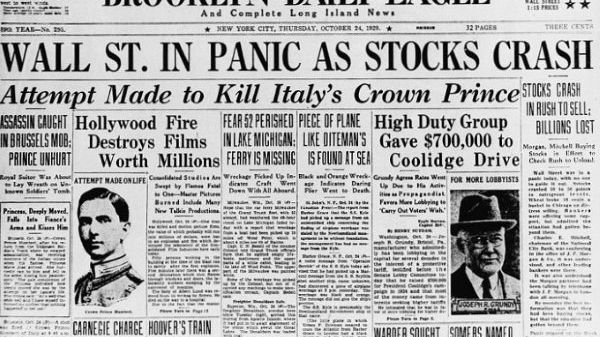A day to remember. A day that shook the socioeconomic climate of the US. A day that took a fall after a big leap. October 29th, 1929 was that day, commonly known as ‘Black Tuesday’.
The first world war took its toll on the economic patterns of every country that took part in it, the US being one of them. But soon after the war ended, America enjoyed economic prosperity, as a result, the 1920s was known as the ‘Roaring Twenties’. Post-war optimism high, technological advancement, expansion of the industrial sector, etc. all contributed to this prosperity. People were given more job opportunities, paid higher wages, luxuries such as radios, automobiles from companies like Ford, etc. were made affordable to the ordinary people. Consumerism was also promoted by the music and radio industry and the Hollywood industry. At this peak, at least 10% of Americans took their chance on the Stock Market and bought stocks through loaned money or through buying on margin, creating the Long Bull Market, increasing stock prices. Investors fought with the best prices to buy the available equity against other investors resulting again, to rocket stock prices. It was believed by many that the stock market would forever continue to rise.
A cause to disbelief was raised on March 25th, 1929, when investors started to sell stocks at a rapid pace, which resulted in a small crash, revealing the true shaky nature of the market. This crash was saved by a banker Charles E. Mitchell after his bank provided over 25 million dollars to catch the market from falling further. But the disbelief shook the American economy as it showed signs of trouble with productions from industries declining, sales of items such as automobiles going down, and consumers building up large debts.
Despite all this turbulence, stocks advanced as usual and gains went up higher up until early September of 1929. Professional investors, economists, and financial experts soon sensed a scent of trouble and alerted others to it noticing the gradual decline in the economy. Share prices began to fall, stocks sold by investors, etc. all lead to the start of the infamous Crash, this initial decline was known to be called the ‘Babson Break’.
There was a gradual decrease in prices till up to early October as speculations continued. Panic struck Wall Street on October 21 as stockbrokers demanded prompt repayment of loans from their clients through large-scale “margin calls”.
The series of events that fell upon the Stock market in the following forever left a mark on the American economy. October 24th, “Black Thursday”, selling of stocks intensified, 11% of the Market’s value lost in a day due to very heavy trading as in almost 13,000,000 shares traded. Investors did not even have any idea on what most stocks were trading for! In an attempt to save the Market from crashing, several bankers bought huge shares, a tactic that helped seize the panic of 1907 but alas this did not help.
Investors still facing margin calls decided together to get out of the market which resulted in it going down the slide with a record loss. About 16 million shares were traded by investors after panic selling of stocks on October 29th, “Black Tuesday”. Millions of Americans lost their savings, billions of dollars wiped out, and thousands of investors, small and big destroyed. This fall in the market continues on for quite some time and resulted in the loss of about $30 billion by mid-November. To regain the money lost and stand steady economically, America took its time. The Dow Jones average reached the peak it lost on September 3rd, 1929 only on November 23rd, 1954!
For such a drastic fall in the economy, there must have been some kind of aftermath that left a mark. And there was, and it’s known as the Great Depression. About 30% of Americans lost their jobs, banks and other organizations went bankrupt. Prices of daily necessities also went up. This aftermath impacted society as a whole and altered the image and the perspective of the entire population on the financial markets and left a mark of its own. The Government at the time did try and bring out measures to lessen the effects but failed terribly. The economy only returned once World War 2 came around.
The Wall Street Crash of 1929 is still a heavily talked about subject even today. It shattered the American economy and left all in astonishment. The impact it left in America is a lesson learned for economies all around the world. This event repeated itself in a lesser magnitude again in 2007-2008.
By Anavadya Nirmalan
Write and Win: Participate in Creative writing Contest & International Essay Contest and win fabulous prizes.
















